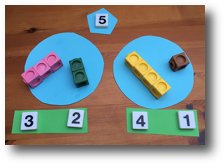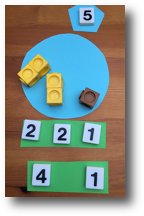Ofsted has expressed concern that the EYFS statutory framework has a number of weaknesses and that expectations, especially in mathematics, are set too low. They found that children were better prepared for Y1 in schools that had more challenging expectations. So, does the EYFS framework need to change?
The Ofsted Annual Report published each December is always worth reading as the findings are based around evidence from around 26000 inspections of schools, colleges and early years foundation stage (EYFS) providers. That is a lot of data collected to analyse! The latest report published in December 2017 once again has some interesting findings and I’m just focussing on a few paragraphs that discuss EYFS provision for mathematics.
"Our early years inspections, whether of a Reception Year, nursery, pre-school or a childminder, are made with reference to the expectations of the ‘Statutory framework for the early years foundation stage’. However, our survey this year showed a number of weaknesses in this as a guide for children’s learning. We found that schools that are best at preparing children for Year 1 are going beyond the framework and setting more challenging expectations." (p.6)
This year, our research into the Reception Year has raised questions about whether the early years foundation stage (EYFS) is appropriately designed to prepare pupils for Year 1.
We reviewed the practice in schools that achieved consistently high outcomes for children, not just at the end of the Reception Year, but in many cases throughout primary school. It was clear that they were, by necessity, departing from the EYFS and that the standards in the guidance were too low, particularly for mathematics.
Leaders and staff in schools were increasing quite considerably their expectations for teaching reading, writing and mathematics. They told us that meeting the early learning goals did not get pupils to a level that was high enough to set them up for success in Year 1. Some schools had designed their own mathematics curriculum based on the national curriculum programmes of study. In these cases, pupils had a good basis for the more complex learning to follow. (p. 14/15)
We reviewed the practice in schools that achieved consistently high outcomes for children, not just at the end of the Reception Year, but in many cases throughout primary school. It was clear that they were, by necessity, departing from the EYFS and that the standards in the guidance were too low, particularly for mathematics.
Leaders and staff in schools were increasing quite considerably their expectations for teaching reading, writing and mathematics. They told us that meeting the early learning goals did not get pupils to a level that was high enough to set them up for success in Year 1. Some schools had designed their own mathematics curriculum based on the national curriculum programmes of study. In these cases, pupils had a good basis for the more complex learning to follow. (p. 14/15)
There are a few assumptions here: firstly, that the main aim of the Foundation Stage is to prepare children for Year 1, and secondly, by highlighting reading, writing and mathematics it may be seen as emphasising these above other aspects of the EYFS classroom. I’m sure many teachers view the purpose of EYFS education as being much broader than this, involving learning and experiences specifically for the development of young children.
However there may be other issues that need to be addressed to ensure children are adequately challenged. This could include staff training and providing worked examples to support the teaching of EYFS mathematics. The Early Learning Goals in mathematics give broad but clear guidance on the expectations for end of FS2. I think it is then for the EYFS providers to interpret those goals, break them down into clear lines of progression and add challenge when necessary to help children become independent thinkers and problem-solvers.
This is the key – it is not about ‘going beyond the framework’ or teaching mathematics ‘based on the national curriculum programmes of study’ aimed at Y1 – it is giving an open-ended problem or task that children could take beyond what may be expected of that age.
EYFS teachers can add depth and challenge through their questioning and planned activities, with play, talk, curiosity, exploration and problem solving the flavour of the maths activities provided.
UPDATE
Since writing this article the DfE have published a new document to add further details to Ofsted's findings: 'Bold Beginnings: The Reception curriculum in a sample of good and outstanding primary schools'.
This has received some understandable criticism as the focus seems to be on 'traditional' teaching methods more appropriate for KS1 and KS2 which seem a long way from EYFS experiences. Here is the key paragraph relating to mathematics (page 24) which gives an idea of their recommendations:
Leaders and staff in the schools visited were clear in how they taught early mathematical concepts. They prioritised:
- the direct teaching of the whole class, with sufficient time to practise and rehearse important processes and skills
- a whole-school ‘teaching for mastery' approach to mathematics
- the use of practical activities and equipment, giving young children materials to manipulate to aid their understanding and lay the foundations for visual images that represent numbers
- counting, numeral recognition and the additive composition of number as the prerequisites for later, more complex mathematical concepts
- traditional games, at school and at home, that enabled children to apply their counting and hone their early calculation skills.
Example: Add and subtract two single-digit numbers
This is a broad topic that can challenge Reception children. Quick recall of facts isn’t expected and strategies for mental calculation are at a very rudimentary stage (counting on is a major step), but Reception children can certainly be challenged when given time to explore different possibilities for addition facts. Here is an activity that shows how depth can be added through partitioning in different ways. Prompts and questions asking 'What do you notice?' will encourage children's reasoning.
EYFS Framework – Early Learning Goals
The Early Years Foundation Stage Framework sets out the end of FS2/Reception expectations, as defined by these Early Learning Goals:
Mathematics
This involves providing children with opportunities to:
· practise and improve their skills in counting numbers, calculating simple addition and subtraction problems
· describe shapes, spaces, and measures
Numbers: children count reliably with numbers from 1 to 20, place them in order and say which number is one more or one less than a given number. Using quantities and objects, they add and subtract two single-digit numbers and count on or back to find the answer. They solve problems, including doubling, halving and sharing.
Shape, space and measures: children use everyday language to talk about size, weight, capacity, position, distance, time and money to compare quantities and objects and to solve problems. They recognise, create and describe patterns. They explore characteristics of everyday objects and shapes and use mathematical language to describe them.
The Early Years Foundation Stage Framework sets out the end of FS2/Reception expectations, as defined by these Early Learning Goals:
Mathematics
This involves providing children with opportunities to:
· practise and improve their skills in counting numbers, calculating simple addition and subtraction problems
· describe shapes, spaces, and measures
Numbers: children count reliably with numbers from 1 to 20, place them in order and say which number is one more or one less than a given number. Using quantities and objects, they add and subtract two single-digit numbers and count on or back to find the answer. They solve problems, including doubling, halving and sharing.
Shape, space and measures: children use everyday language to talk about size, weight, capacity, position, distance, time and money to compare quantities and objects and to solve problems. They recognise, create and describe patterns. They explore characteristics of everyday objects and shapes and use mathematical language to describe them.
Cube split
Working in pairs, children take it in turns to split a 5 cube train into two sets and write the addition. Their partner checks by counting and adding.
Prompts:
Have you found all the possible ways? How do you know?
Can you split the train into three sets? What do you notice?
Try splitting a 6 cube train. How many different ways have you found?
For Broadbent Maths users there are supported planning resources for FS/R including medium term plans ofr 18 maths topics and topic templates that inlcude learning objectives, expected outcomes, AfL activities, vocabulary and small steps of progression for that topic.
Samples are available, please state that you are interested in FS/R samples.
Samples are available, please state that you are interested in FS/R samples.
Related articles:
Growth mindset and teaching
Look at your own attitude to maths and can you change?
Growth mindset and teaching
Look at your own attitude to maths and can you change?





